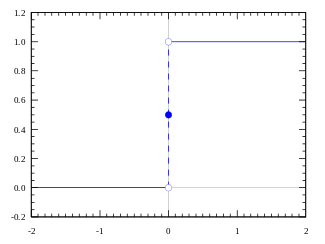Step function
This article is about a piecewise constant function. For the unit step function, see Heaviside step function.
In mathematics, a function on the real numbers is called a step function (or staircase function) if it can be written as a finite linear combination of indicator functions of intervals. Informally speaking, a step function is a piecewise constant function having only finitely many pieces.

Example of a step function (the red graph). This particular step function is right-continuous.
Definition and first consequences
A function is called a step function if it can be written as
- for all real numbers
where are real numbers, are intervals, and (sometimes written as ) is the indicator function of :
In this definition, the intervals can be assumed to have the following two properties:
- The intervals are pairwise disjoint, for
- The union of the intervals is the entire real line,
Indeed, if that is not the case to start with, a different set of intervals can be picked for which these assumptions hold. For example, the step function
can be written as
Examples

The Heaviside step function is an often-used step function.
- A constant function is a trivial example of a step function. Then there is only one interval,
- The sign function , which is −1 for negative numbers and +1 for positive numbers, and is the simplest non-constant step function.
- The Heaviside function H(x), which is 0 for negative numbers and 1 for positive numbers, is an important step function, and is equivalent to the sign function, up to a shift and scale of range (). It is the mathematical concept behind some test signals, such as those used to determine the step response of a dynamical system.

The rectangular function, the next simplest step function.
- The rectangular function, the normalized boxcar function, is the next simplest step function, and is used to model a unit pulse.
Non-examples
- The integer part function is not a step function according to the definition of this article, since it has an infinite number of intervals. However, some authors[1] also define step functions with an infinite number of intervals.[1]
Properties
- The sum and product of two step functions is again a step function. The product of a step function with a number is also a step function. As such, the step functions form an algebra over the real numbers.
- A step function takes only a finite number of values. If the intervals in the above definition of the step function are disjoint and their union is the real line, then for all
- The definite integral of a step function is a piecewise linear function.
- The Lebesgue integral of a step function is where is the length of the interval and it is assumed here that all intervals have finite length. In fact, this equality (viewed as a definition) can be the first step in constructing the Lebesgue integral.[2]
See also
- Unit step function
- Crenel function
- Simple function
- Piecewise defined function
- Sigmoid function
- Step detection
References
This article is issued from Wikipedia - version of the 9/2/2016. The text is available under the Creative Commons Attribution/Share Alike but additional terms may apply for the media files.